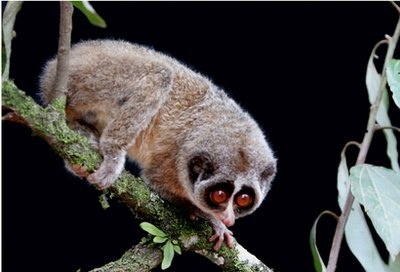Horton Plains Slender Loris Rediscovered
Posted by: Loren Coleman on July 20th, 2010

This is an undated handout photo issued Monday July 19, 2010 by the Zoological Society of London (ZSL) of a Horton Plains slender loris, sitting on a forest branch in a mountain forest in central Sri Lanka. Researchers say they photographed the rare primate thought to have been extinct for more than 60 years in a forest in central Sri Lanka. The Zoological Society of London report a Horton Plains slender loris with wide eyes and short limbs has been caught on camera by ZSL and Sri Lankan researchers after they surveyed forest patches for more than 200 hours, looking for signs of the primate. (Zoological Society of London/Credit Ho)
The Red Slender Loris (Loris tardigradus) is a small, nocturnal prosimian native to the rainforests of Sri Lanka. This is #6 of the 10 focal species and #22 of the 100 EDGE mammal species worldwide considered the most Evolutionarily Distinct and Globally Endangered. Two subspecies have been identified, L. t. tardigradus and L. t. nycticeboides.
The Red Slender Loris was identified as one of the top-10 “focal species” in 2007 by the Evolutionarily Distinct and Globally Endangered (EDGE) project.
One early success has been the rediscovery of the virtually unknown Horton Plains slender loris (Loris tardigradus nycticeboides) – pictured here. Originally documented in 1937, there have only been four known encounters in the past 72 years. The rediscovery and capture by the team (working under the ZSL EDGE programme) has resulted in the first detailed physical examination of this subspecies.
Here is a widely dispatched overview of this rediscovery:
A “cute” primate so rare it was thought to be extinct has been caught on camera in the forests of Sri Lanka for the first time, scientists said [on July 19, 2010].
The Horton Plains slender loris is a small, nocturnal animal which can grow up to 17 centimetres (six inches) long with big, bulging eyes.
Endemic to Sri Lanka, it was first discovered in 1937 but had only been seen four times since then.
Scientists last caught a glimpse of the primate in 2002, and believed the elusive animal had since died out.
But field researchers, working with the Zoological Society of London, managed to track down the mysterious creature in the forests of central Sri Lanka.
In a world first, they were able to take pictures of an adult male slender loris sitting on a tree branch.
The field team was able to capture one of the creatures and give it a physical examination, the first time that has ever been done, before releasing it back into the wild.
But experts warned that deforestation in Sri Lanka — largely blamed on the drive to create tea plantations in the region — was now the biggest threat to the loris.
Craig Turner, a conservation biologist at the ZSL, said their natural forest habitat had been divided up for farming and logging use, cutting off the “very cute” animals from their partners.
“The forest has now been fragmented into a series of small islands,” Turner told BBC radio.
“They can’t move to one another, they can’t mate, breed, so it has real implications for the future persistence of the species.”
Credit: AFP.

About Loren Coleman
Loren Coleman is one of the world’s leading cryptozoologists, some say “the” leading living cryptozoologist. Certainly, he is acknowledged as the current living American researcher and writer who has most popularized cryptozoology in the late 20th and early 21st centuries.
Starting his fieldwork and investigations in 1960, after traveling and trekking extensively in pursuit of cryptozoological mysteries, Coleman began writing to share his experiences in 1969. An honorary member of Ivan T. Sanderson’s Society for the Investigation of the Unexplained in the 1970s, Coleman has been bestowed with similar honorary memberships of the North Idaho College Cryptozoology Club in 1983, and in subsequent years, that of the British Columbia Scientific Cryptozoology Club, CryptoSafari International, and other international organizations. He was also a Life Member and Benefactor of the International Society of Cryptozoology (now-defunct).
Loren Coleman’s daily blog, as a member of the Cryptomundo Team, served as an ongoing avenue of communication for the ever-growing body of cryptozoo news from 2005 through 2013. He returned as an infrequent contributor beginning Halloween week of 2015.
Coleman is the founder in 2003, and current director of the International Cryptozoology Museum in Portland, Maine.










That is awesome news. Thats one thing I have never gotten, how a brand new aboreal fruit eating monitor species can only get one article on this site but a delerious elderly man claiming to see big foot can get like twenty. It just doesn’t make sence.
Horton, eh? And they thought it was extinct, now?
I can almost imagine the little fella shouting to the camera man “we are here we are here we are here!” 😛